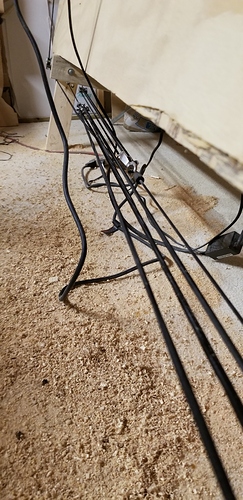the force pulling both down and to both lower corners will be constant with a counter weight system. While the opposite counter weight will pull away from the corner, it is balanced by the close counter weight, and the applied force from that close counter weight will be specifically in the intended direction. Locating the pulleys below the bottom of the work area will also aid in positioning the sled. The main advantage here is in adding an x-axis vector of force to the sled in addition to the y-axis vector, whereas the brick method only provides a y-axis vector and relies on that force to pull the sled in the x-axis by virtue of the sled acting as a pendulum on the nearly vertical chain. If it ends up being a concern, then the bricks and the counter weight could be used in tandem with less weight (one brick?) being on the sled.
I agree, which I why I suggest using an eye nut (rather than an eyelet or eye screw) on counter sunk (on the bottom of the sled) through bolts.
2 liter bottles filled with water? there are options galore. It’s not to say that getting bricks is hard, but some have expressed difficulty. Bricks are also fairly large and a little unwwieldy. I am currently using some lead ingots that I had lying around from another project, which allows me to keep the weight within the outline of the sled, which could be a bonus for some who need to limit the vertical height of the whole set up as bricks seem to extend the bottom of the sled a couple inches. I know it’s not a lot, but there are certainly people who have already expressed an interest in minimizing any additional height.
I haven’t thought the connection all the way through, but a couple of ideas spring to mind including a single attachment point to the sled (which would allow the counter weights to balance themselves when removed), or having a cleat at each bottom pulley to secure them on removal. It would have to be worked out for sure, but this is just an initial run at it, so certainly time to collaborate with those interested to find a good solution.
That would be pretty cool. I’d be interested in that solution, though their is certainly an added complexity and cost associated with that as well.
That is fair, but it still seems like something to explore. There’s always the chance that there’s no benefit in it, but aside from speculation at this point, there’s no way to know without further study and/or experimentation. And it may not be for everyone (after all, there are a lot of different frame designs out there), but for some it might be ideal for one reason or another.
also, apologies to @Jacob, I did not mean to hijack your thread. When I have a little more time I will pull this conversation out to a new thread. I’d also appreciate a tag in your follow-up
(perhaps that is where this discussion should go? thoughts?)**

 please correct me if Im wrong but I think the key was to have the bungie pulling in line with the bit (same as the chains)
please correct me if Im wrong but I think the key was to have the bungie pulling in line with the bit (same as the chains) . That would take some additional steering of the trolley/traveller, though. An improvement beyond that would put more force on the bungee when the sled is close to the bottom of the workarea, less when near the top (more force when the angle between the chains reduced, less when the angle increased). Not asking for much, am I?
. That would take some additional steering of the trolley/traveller, though. An improvement beyond that would put more force on the bungee when the sled is close to the bottom of the workarea, less when near the top (more force when the angle between the chains reduced, less when the angle increased). Not asking for much, am I? 




